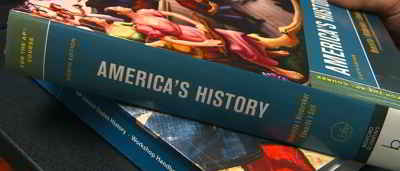
US State Histories
- State Names
- Resident's Names
- Origin of State Name
- On This Day in History
- Mottos Listed (ALL)
- Statehood
- State Facts - History Firsts
- State Preambles
- US Famous People
- US Early Histories
- US History Timelines
- US County Histories
- US Presidents (POTUS)
- Presidential Succession
- History of the States
- The 50 US States
US State Histories: Overviews of US History
State Historic Facts and Overviews of US History
History began with written records. To understand the past, historians read documents left behind by earlier people. Of course, people existed before written records. According to scholars, these people are "prehistoric." "Prehistoric" simply means before written records.
History began at various times for the different people that make up the world's population, as not all people developed writing at the same time. Jump to "Start of the History of the United States"
The date of the start of the history of the United States is a subject of debate among historians. Older textbooks start with the arrival of Christopher Columbus in 3 August 1492 and emphasize the European background, or they start around 1600 and emphasize the American frontier. In recent decades American schools and universities typically have shifted back in time to include more on the colonial period and much more on the prehistory of the Native peoples
The United States of America itself has over 200 years of history, relatively short compared to other countries and nations. However, the United States has a rich and proud history that has experienced much. From Independence to the Civil War to the World Wars to the Cold War, we have a lot of things to tell and things to be proud of.
Take a peek at each of the fifty (50) state's history and heritage that transformed the United States at the turn of the century, as well as details on population, geography, and facts. Access official symbols, emblems, and mascots.
US State Histories: States Historical Overview
- Louisiana History
- Maine History
- Maryland History
- Massachusetts History
- Michigan History
- Minnesota History
- Mississippi History
- Missouri History
- Montana History
- Nebraska History
- Nevada History
- New Hampshire History
- New Jersey History
- New Mexico History
- New York History
- North Carolina History
- North Dakota History
- Ohio History
- Oklahoma History
- Oregon History
- Pennsylvania History
- Rhode Island History
- South Carolina History
- South Dakota History
- Tennessee History
- Texas History
- Utah History
- Vermont History
- Virginia History
- Washington History
- Washington, DC History
- West Virginia History
- Wisconsin History
- Wyoming History
- US History
Start of the History of the United States
The prehistory of the Americas (North, South, and Central America, and the Caribbean) begins with people migrating to these areas from Asia during the height of an Ice Age. These groups are generally believed to have been isolated from peoples of the "Old World" until the coming of Europeans in the 10th century from Norway and with the Voyages of Christopher Columbus in 1492.
The ancestors of today's American Indigenous peoples were the Paleo-Indians; they were hunter-gatherers who migrated into North America. The most popular theory asserts that migrants came to the Americas via the Bering Land Bridge, Beringia, the land mass now covered by the cold ocean waters in the Bering Strait. Small lithic stage peoples followed megafauna like bison, mammoth (now extinct), and caribou, thus gaining the modern nickname "big-game hunters." Groups of people may also have traveled into North America on shelf or sheet ice along the northern Pacific coast.
Cultural traits brought by the first immigrants later evolved and spawned such cultures as Iroquois on North America and Piraha of South America. These cultures later developed into civilizations.




